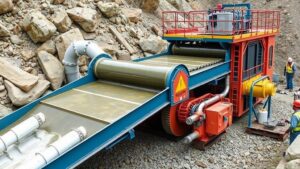Techniques for Drilling and Blasting in Small-Scale Mining Operations
Techniques for Drilling and Blasting in Small-Scale Mining Operations
Small-scale mining operations play a crucial role in the extraction of minerals, serving as a livelihood for millions of people worldwide. Efficient techniques for drilling and blasting are essential for maximizing productivity while minimizing environmental impacts and safety risks. This article explores the various methods employed in small-scale mining, focusing on their effectiveness and real-world applications.
Understanding Drilling Techniques
In the context of small-scale mining, drilling serves as the first step in the blasting process. effectiveness of drilling determines the overall success of subsequent blasting operations. Key drilling techniques include:
- Rotary Drilling: Uses a rotating drill bit to penetrate rock formations. This technique is effective for creating deep holes, typically ranging from 3 to 5 inches in diameter. For example, in placer gold mining, rotary drilling is often employed to find mineralized zones.
- Percussive Drilling: Relies on a hammer mechanism that strikes the drill bit into the rock. It is particularly useful for hard rock mining where greater force is required. The method is known for its speed, accommodating up to 200 feet per hour in some cases.
Both techniques have their advantages and disadvantages, with rotary drilling being more suited for softer formations, while percussive drilling excels in harder materials.
Blast Design Considerations
Effective blast design is a critical component of successful drilling and blasting practices. Properly designed blasts can improve fragmentation and minimize ground vibration, which is vital for the safety of mining operations and nearby communities. Factors influencing blast design include:
- Geological Conditions: Understanding the type of rock, its structure, and its properties is essential. For example, using a lower density explosive in softer rocks can reduce unintentional damage.
- Air Decking: This technique involves leaving a void in the blasthole to reduce energy waste and enhance fragmentation. By adjusting the air deck size, miners can optimize the energy transfer to the rock.
Data from industry case studies indicate that optimal blast design can increase fragmentation efficiency by up to 30%, leading to improved downstream processing.
Choosing the Right Explosives
The selection of explosives is fundamental to the success of any blasting operation. Common types of explosives include:
- Ammonium Nitrate Fuel Oil (ANFO): This widely used explosive is favored for its cost-effectiveness and reliability. ANFO is suitable for dry holes and performs best in blasting applications in soft to medium-hard rocks.
- Emulsion Explosives: Known for their water resistance, emulsion explosives are ideal for wet mining conditions. r versatility allows for use in various geological settings.
The efficiency of the chosen explosive can directly influence the costs and effectiveness of the operation; thus small-scale miners must carefully evaluate their options based on the specific conditions of their sites.
Safety and Environmental Considerations
Safety is paramount in drilling and blasting operations. Miners must adhere to strict safety protocols to protect both workers and surrounding communities. Some recommended practices include:
- Risk Assessments: Conducting thorough risk assessments before blasting can help identify potential hazards and mitigate risks.
- Community Communication: Engaging with local communities about planned blasting operations can address concerns and effectively manage expectations regarding noise and vibration.
Plus, implementing measures to minimize environmental impact–such as monitoring air quality and controlling dust–ensures compliance with regulatory requirements and promotes sustainability.
Real-World Applications and Case Studies
A notable example of effective drilling and blasting in small-scale mining can be found in the artisanal gold mining operations of Ghana. Here, miners have adopted a combination of rotary and percussive drilling techniques tailored to local geological conditions, resulting in improved mineral recovery rates. Also, community engagement initiatives have led to a more harmonious relationship between miners and local residents, addressing safety concerns and environmental impacts.
In contrast, a case study from the Andes of Peru highlights the consequences of ineffective blast design, where inadequate explosive selection led to significant ground vibration and subsequent rock falls, resulting in injuries and operational disruptions. This example underscores the importance of optimizing blast designs and selecting appropriate explosives.
Actionable Takeaways
For small-scale mining operators, the following strategies can enhance drilling and blasting operations:
- Invest in Training: Continuous education on the latest drilling and blasting techniques can lead to improved operational efficiency.
- Regularly Evaluate Geological Conditions: Understanding the changing geology of a site will enable miners to adapt their methods and strategies accordingly.
By applying these techniques and lessons learned from successful operations, small-scale miners can not only increase their productivity but also advance their commitment to safety and environmental stewardship.


